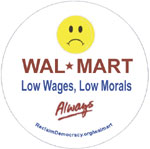By Ben Manski – Published October 3, 2011
The protests that began in Wisconsin this year, and which now also fill the streets of Manhattan, Boston, Chicago, and this week, Washington D.C., have gotten the attention of the American political class. And how could they not? 2011 is becoming a remake of the 1999 Battle of Seattle, except this time the protests are ongoing, national and global, and the target is not just the World Trade Organization, but the entire edifice of corporate capitalism.
So the political class, rather than ignore this wave of protests, pulls a card from the past. They know we are angry, they say. They just don’t understand what we want. We speak in too many voices. According to the American Pravda, The New York Times (which tells the professional classes their truth), we are a “hodgepodge” and “confused” movement with “unclear goals” and “nowhere to go.” Why can’t we settle on a couple key demands?
What some can’t accept, they pretend not to understand . And the political class can’t accept that the common demand of the current protest wave is for democratic revolution. We want them gone. We want power.
We haven’t been secretive about our goals. The Wisconsin Wave was launched in February as a “democracy movement.” Occupy Wall Street calls for an “American Revolution.” The October2011.org occupation of Freedom Plaza in D.C. intends to “Create a New World.” Perhaps, as Thomas Paine once penned, “The birthday of a new world is at hand.”
Democracy is a simple idea. It means “the people rule.” The promise of the United States is democracy. The reality is that corporate elites rule. The contradiction between the promise and reality of America has produced a movement to make the promise the new reality.
We believe it our birthright to directly participate in power. Elections were always a poor substitute for participatory democracy. And elections delegate power from the people to a tiny elite easily browbeaten or bought off by major corporations. Most Americans intuitively know this.
And we have an alternative. A new democratic economy is growing amidst the collapse of the old one. The cooperative sector –made up of coops, credit unions, and community supported and community owned enterprises– now includes over one third of the American people. Having tasted real democracy, after having been force fed the fake formula, millions are demanding more of the real thing.
We also understand that freedom to govern requires freedom from want. The rights to housing, to an education, to health care, to child care, to a livable income, are all democratic rights. People who don’t have these necessities of life are not free to participate in power. The impoverishment of Americans is the impoverishment of America.
Students of social change learn that mass movements are most likely to emerge at times when economic conditions become intolerable. For tens of millions of Americans, those times are now. This is especially true for young people, among them the many veterans of the unending wars.
The present form of government fails to provide for the pursuit of their happiness . They see that the time has come to alter or abolish it, and to institute a new one. The political class cannot accept this, and so fails to understand it. People in the streets, from Wisconsin to Wall Street to Washington D.C. are proving that we understand it perfectly well.
Ben Manski is the Executive Director of the Liberty Tree Foundation, a national strategy center dedicated to “building a democracy movement for the U.S.A.,” and the initiator of the Wisconsin Wave protest movement.
© 2011 Ben Manski



